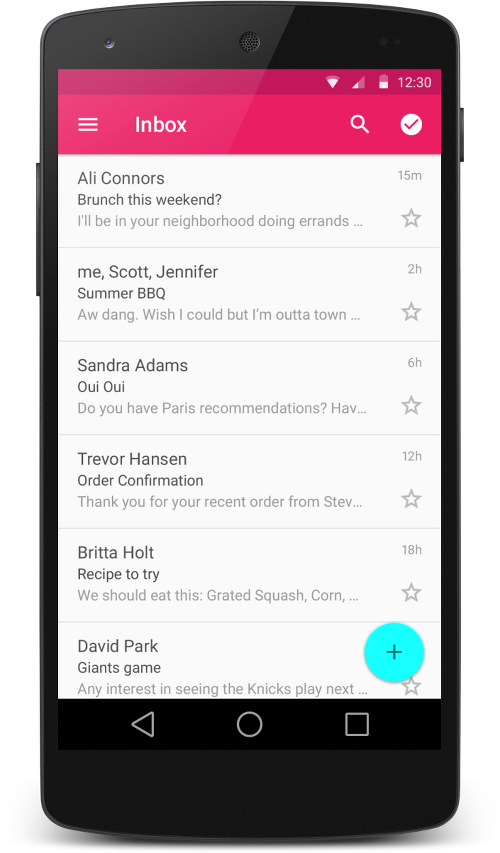Creating Lists and Cards 创建列表和卡片
To create complex lists and cards with material design styles in your apps, you can use the RecyclerView and CardView widgets.
//想要创建复杂的带有material design风格的列表,使用RecyclerView 和 CardView widget
Create Lists
The RecyclerView widget is a more advanced and flexible version of ListView. This widget is a container for displaying large data sets that can be scrolled very efficiently by maintaining a limited number of views. Use the RecyclerView widget when you have data collections whose elements change at runtime based on user action or network events.
The RecyclerView class simplifies the display and handling of large data sets by providing:
- Layout managers for positioning items
- Default animations for common item operations, such as removal or addition of items //对移除或者添加等常用条目的行为都有默认的动画
You also have the flexibility to define custom layout managers and animations for RecyclerView widgets.

Figure 1. The RecyclerView widget.
To use the RecyclerView widget, you have to specify an adapter and a layout manager. To create an adapter, extend the RecyclerView.Adapter class. The details of the implementation depend on the specifics of your dataset and the type of views. For more information, see the examples below.

Figure 2 - Lists with RecyclerView.
A layout manager positions item views inside a RecyclerView and determines when to reuse item views that are no longer visible to the user. To reuse (or recycle) a view, a layout manager may ask the adapter to replace the contents of the view with a different element from the dataset. Recycling views in this manner improves performance by avoiding the creation of unnecessary views or performing expensive findViewById() lookups.
//layout manager负责排布recyclerview中的视图条目,并且决定当一些条目不在可见时什么时候重用条目。为了重用view,layout manager可能会向adapter请求用不同的数据库的数据带替换view中的内容。
RecyclerView provides these built-in layout managers:
LinearLayoutManagershows items in a vertical or horizontal scrolling list. //以水平或者垂直的滚动列表形式显示条目GridLayoutManagershows items in a grid. //以网格形式显示StaggeredGridLayoutManagershows items in a staggered grid.//以交错网格形式展示
To create a custom layout manager, extend the RecyclerView.LayoutManager class.
Animations
Animations for adding and removing items are enabled by default in RecyclerView. To customize these animations, extend the RecyclerView.ItemAnimator class and use the RecyclerView.setItemAnimator()method.
//为了定制动画,继承RecyclerView.ItemAnimator 类,并且使用RecyclerView.setItemAnimator()方法来设置
Examples
The following code example demonstrates how to add the RecyclerView to a layout:
<!-- A RecyclerView with some commonly used attributes -->
<android.support.v7.widget.RecyclerView
android:id="@+id/my_recycler_view"
android:scrollbars="vertical"
android:layout_width="match_parent"
android:layout_height="match_parent"/>
Once you have added a RecyclerView widget to your layout, obtain a handle to the object, connect it to a layout manager, and attach an adapter for the data to be displayed:
public class MyActivity extends Activity {
private RecyclerView mRecyclerView;
private RecyclerView.Adapter mAdapter;
private RecyclerView.LayoutManager mLayoutManager;
@Override
protected void onCreate(Bundle savedInstanceState) {
super.onCreate(savedInstanceState);
setContentView(R.layout.my_activity);
mRecyclerView = (RecyclerView) findViewById(R.id.my_recycler_view);
// use this setting to improve performance if you know that changes
// in content do not change the layout size of the RecyclerView
//使用这个设置来提高性能,如果你已经知道了内容的修改不会改变recyclerview的布局大小
mRecyclerView.setHasFixedSize(true);
// use a linear layout manager
mLayoutManager = new LinearLayoutManager(this);
mRecyclerView.setLayoutManager(mLayoutManager);
// specify an adapter (see also next example)
mAdapter = new MyAdapter(myDataset);
mRecyclerView.setAdapter(mAdapter);
}
...
}
The adapter provides access to the items in your data set, creates views for items, and replaces the content of some of the views with new data items when the original item is no longer visible. The following code example shows a simple implementation for a data set that consists of an array of strings displayed using TextView widgets:
public class MyAdapter extends RecyclerView.Adapter<MyAdapter.ViewHolder> {
private String[] mDataset;
// Provide a reference to the views for each data item
// Complex data items may need more than one view per item, and
// you provide access to all the views for a data item in a view holder
public static class ViewHolder extends RecyclerView.ViewHolder {
// each data item is just a string in this case
public TextView mTextView;
public ViewHolder(TextView v) {
super(v);
mTextView = v;
}
}
// Provide a suitable constructor (depends on the kind of dataset)
public MyAdapter(String[] myDataset) {
mDataset = myDataset;
}
// Create new views (invoked by the layout manager)
@Override
public MyAdapter.ViewHolder onCreateViewHolder(ViewGroup parent,
int viewType) {
// create a new view
View v = LayoutInflater.from(parent.getContext())
.inflate(R.layout.my_text_view, parent, false);
// set the view's size, margins, paddings and layout parameters
...
ViewHolder vh = new ViewHolder(v);
return vh;
}
// Replace the contents of a view (invoked by the layout manager)
@Override
public void onBindViewHolder(ViewHolder holder, int position) {
// - get element from your dataset at this position
// - replace the contents of the view with that element
holder.mTextView.setText(mDataset[position]);
}
// Return the size of your dataset (invoked by the layout manager)
@Override
public int getItemCount() {
return mDataset.length;
}
}

Figure 3. Card examples.
Create Cards
CardView extends the FrameLayout class and lets you show information inside cards that have a consistent look across the platform. CardView widgets can have shadows and rounded corners.
To create a card with a shadow, use the card_view:cardElevation attribute. CardView uses real elevation and dynamic shadows on Android 5.0 (API level 21) and above and falls back to a programmatic shadow implementation on earlier versions. For more information, see Maintaining Compatibility.
//为了创建带有阴影的卡片,使用card_view:cardElevation属性,cardview使用真是的正视图和动态的阴影效果在Android 5.0及以上的平台上,在较早版本上使用代码来实现。
Use these properties to customize the appearance of the CardView widget:
- To set the corner radius in your layouts, use the
card_view:cardCornerRadiusattribute. //为了设置布局的圆角,使用card_view:cardCornerRadius属性 - To set the corner radius in your code, use the
CardView.setRadiusmethod. //在代码中设置圆角,使用CardView.setRadius方法 - To set the background color of a card, use the
card_view:cardBackgroundColorattribute. //给卡片设置背景的属性
The following code example shows you how to include a CardView widget in your layout:
<LinearLayout xmlns:android="http://schemas.android.com/apk/res/android"
xmlns:tools="http://schemas.android.com/tools"
xmlns:card_view="http://schemas.android.com/apk/res-auto"
... >
<!-- A CardView that contains a TextView -->
<android.support.v7.widget.CardView
xmlns:card_view="http://schemas.android.com/apk/res-auto"
android:id="@+id/card_view"
android:layout_gravity="center"
android:layout_width="200dp"
android:layout_height="200dp"
card_view:cardCornerRadius="4dp"> <TextView
android:id="@+id/info_text"
android:layout_width="match_parent"
android:layout_height="match_parent" />
</android.support.v7.widget.CardView>
</LinearLayout>
For more information, see the API reference for CardView.
Add Dependencies
The RecyclerView and CardView widgets are part of the v7 Support Libraries. To use these widgets in your project, add these Gradle dependencies to your app's module:
dependencies {
...
compile 'com.android.support:cardview-v7:21.0.+'
compile 'com.android.support:recyclerview-v7:21.0.+'
}
Creating Lists and Cards 创建列表和卡片的更多相关文章
- Android Material Design-Creating Lists and Cards(创建列表和卡)-(三)
转载请注明出处:http://blog.csdn.net/bbld_/article/details/40430319 翻译自:http://developer.android.com/trainin ...
- Material Design系列第八篇——Creating Lists and Cards
Creating Lists and Cards //创建列表和卡片 To create complex lists and cards with material design styles in ...
- Android(Lollipop/5.0) Material Design(四) 创建列表和卡片
Material Design系列 Android(Lollipop/5.0)Material Design(一) 简单介绍 Android(Lollipop/5.0)Material Design( ...
- Creating Apps With Material Design —— Creating Lists and Cards
转载请注明 http://blog.csdn.net/eclipsexys 翻译自Developer Android.时间仓促,有翻译问题请留言指出,谢谢 创建Lisst和Cards 在你的应用程序创 ...
- 使用Material Design 创建App翻译系列---列表和卡片集的创建
上一篇是使用Material Design 创建App翻译系列--材料主题的使用(Using Material Theme),进入正题: 想要在应用里创建Material Design风格的复杂列表和 ...
- sharepoint 2010 使用自定义列表模版创建列表(2)
前面用的方法是通过界面上操作,根据自定义模版,创建的列表.sharepoint 2010 使用自定义列表模版创建列表(1) 这里顺便记录多另一种方法,通过程序来创建. ---------------- ...
- SharePoint 创建列表并使用Windows Presentation Foundation应用程序管理列表
SharePoint创建列表并使用程序管理列表 列表是SharePoint开发者输入数据的方式之中的一个.使用Web界面创建一个列表并加入一些数据.过程例如以下: 1. 打开站点. 2 ...
- SharePoint2010新特性:InfoPath定义创建列表的界面
在SharePoint2007的时候,自定义的列表可以使用CAML修改其展示页面,但是对于创建列表的页面,不容易自定义.现在在SharePoint2010中,增强了InfoPath Form Serv ...
- 《Python CookBook2》 第四章 Python技巧 - 若列表中某元素存在则返回之 && 在无须共享引用的条件下创建列表的列表
若列表中某元素存在则返回之 任务: 你有一个列表L,还有一个索引号i,若i是有效索引时,返回L[i],若不是,则返回默认值v 解决方案: 列表支持双向索引,所以i可以为负数 >>> ...
随机推荐
- C++ 性能剖析 (一)
C++ 性能剖析 (一) 性能问题也不是仅仅用“技术”可以解决的,它往往是架构,测试,假设等综合难题.不过,对于一个工程师来说,必须从小做起,把一些“明显”的小问题解决.否则的话积小成多,千里堤坝,溃 ...
- ubuntu 下安装nginx
y@y:~$ sudo apt-get install nginx y@y:~$ sudo service nginx start y@y:~$ nginx默认使用80端口,打开浏览器输入:http: ...
- 【Maven实战】Maven开发环境的搭建和案例展示
1.首先到www.apache.org中下载maven,得到一个apache-maven-3.1.0-bin.zip的压缩包. 2.将此压缩包解压,这里解压到D:\docs中,然后找到maven的bi ...
- 【HDOJ】1314 Numerically Speaking
学了几天的Java了,终于独立A了一道大数计算.感觉还得练Java啊. import java.util.Scanner; import java.math.BigInteger; import ja ...
- Linux&shell之如何控制脚本
写在前面:案例.常用.归类.解释说明.(By Jim) Ctrl+C组合键可以生产SIGINT信号Ctrl+Z组合键生产SIGTSTP信号,停止进程后程序仍然留在内存中,能够从停止的地方继续运行. 捕 ...
- 【转】android开发 dts、各种接口porting----不错
原文网址:http://www.xuebuyuan.com/1023185.html 1. repo init -u git://review.sonyericsson.net/platform/ma ...
- Python核心编程 练习
2–9.循环和运算符 创建一个包含五个固定数值的列表或元组,输出他们的平均值.本练习的难点之一是通过除法得到平均值. 你会发现整数除会截去小数,因此你必须使用浮点除以得到更精确的结果. float() ...
- UVa 11292 - Dragon of Loowater(排序贪心)
Once upon a time, in the Kingdom of Loowater, a minor nuisance turned into a major problem.The shore ...
- 【2013长沙区域赛】部分题解 hdu4791—4801
1001: 签到题,二分一下即可 代码: #include <set> #include <map> #include <cmath> #include <c ...
- Spring 4.0 StandaloneMockMvcBuilder java.lang.NoClassDefFoundError: javax/servlet/SessionCookieConfig 问题解决
standaloneSetup(clrr). build(); 执行第二行 build() 时,出现下面的错误提示. java.lang.NoClassDefFoundError: javax/ser ...
